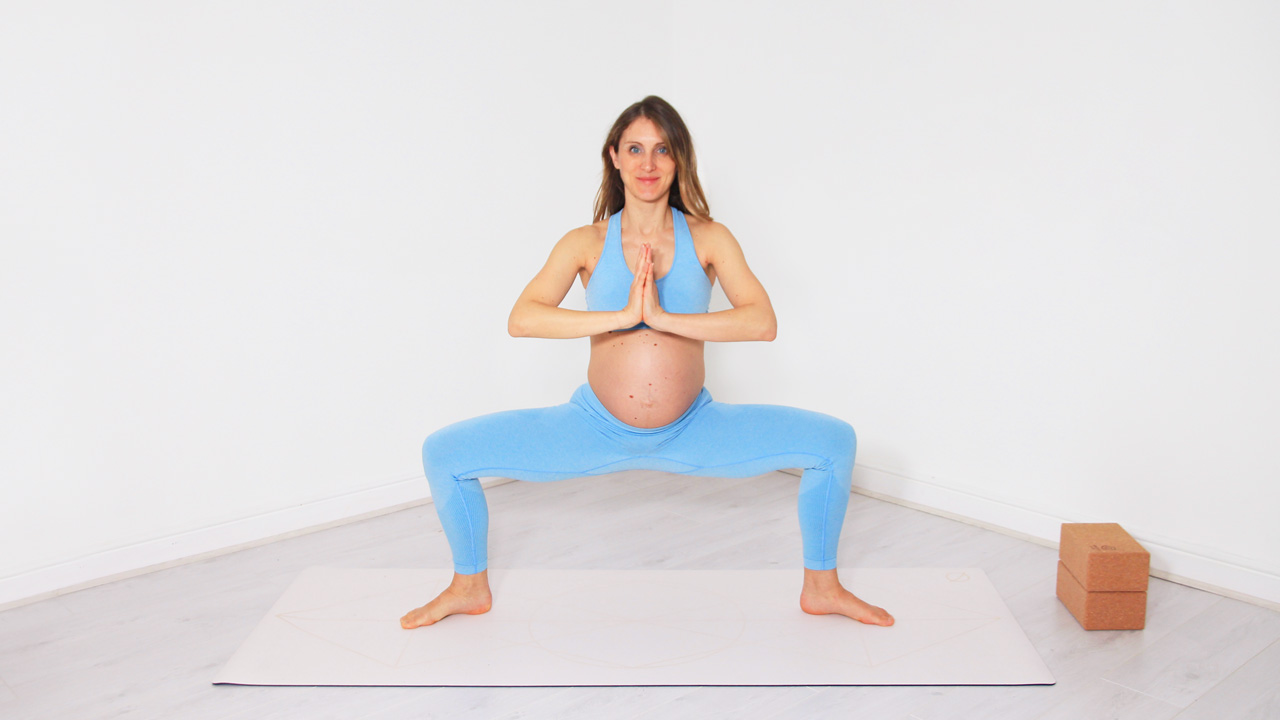Yoga is one of the most beneficial activities to enhance both your and your baby’s health during pregnancy. Research shows it can help reduce stress and anxiety, as well as help prepare your body for birth and potentially even reduce the duration of labour. If you’re a yoga practitioner who is pregnant for the first time, or you’ve recently discovered yoga during pregnancy, it’s natural to have some questions about how to practice safely to nurture and protect your growing bump and your own body.
We’ve created your ultimate guide to online pregnancy yoga, so you can find everything you need in one place to help you practice with confidence as you move through the transformative journey of becoming a mother (or becoming a mother again!). Along with suggested classes, guided pregnancy programs and further reading, we’ll also cover:
- 5 key benefits of pregnancy yoga
- How to practice yoga safely during pregnancy
- Should you change your yoga practice when pregnant?
- Where to find our pregnancy yoga classes
- The best yoga poses for pregnancy
- Yoga poses to avoid when pregnant
- Breathing practices for pregnancy
- How to set up your prenatal yoga space
*Click on the links above to jump directly to that topic.
Prenatal yoga or pregnancy yoga?
First, a word on terms – since pregnancy yoga is more commonly used in the UK and prenatal yoga in the US, we’ll use the two terms interchangeably. Essentially with both terms we’re referring to ‘yoga practiced before giving birth’. Postnatal (or Postpartum) resources will be referred to later in this guide.
What is prenatal yoga, and how does it differ from regular yoga?
The word ‘yoga’ is derived from the root word ‘yuj’, meaning to ‘join’ or ‘unite’. Yoga is thousands of years old, and when practicing, you may feel a sense of ‘unity’ with your body and mind, or perhaps more connected with yourself. Pregnancy yoga is specifically designed for pregnant women, and can encourage a sense of deeply connection to yourself and your growing baby. Also known as ‘prenatal yoga’ or ‘antenatal yoga’, pregnancy yoga is intended to relax the body and mind, support a healthy pregnancy, and prepare your body for birth.
1. 5 key benefits of pregnancy yoga
Research shows prenatal yoga can support physical, emotional, physical and spiritual health throughout pregnancy, benefitting both mum and baby. Here are 5 key benefits:
Reduced stress and anxiety
Through movement, stillness, breathing and meditation, we know that pretty much all styles of yoga can help reduce stress and anxiety. Throughout pregnancy however, stress and anxiety can be incredibly common; we may worry about our bodies, the health of our baby, and feel anxious about the unknown and unexpected. Studies show that pregnancy yoga can be more beneficial than many other interventions in reducing stress and anxiety, as well as reducing the instances of prenatal depression.
Reduced aches and pains
Pregnancy can come with its fair share of aches and pains, from PGP (pelvic girdle pain), to lower back pain, groin pain, and generally feeling more achy due to the increased effort it can take to simply climb the stairs or do the housework! A regular practice of pregnancy yoga can help relieve tightness, tension and pain, as well as build strength around joints. It’s important to remember that due to the increased levels of the hormone ‘relaxin’ in the body throughout pregnancy, you may be more flexible than normal, so be sure not to over-stretch.
Improved pelvic floor and core strength
Throughout pregnancy, it’s likely you’ve been told how important it is to practice pelvic floor exercises to protect your body throughout pregnancy and after baby arrives. Yoga is a great way to naturally encourage pelvic floor strength, through standing postures such as chair pose and warrior poses. Whilst you won’t be practicing many traditional abdominal exercises during pregnancy, just moving through the poses can help you maintain core strength without putting strain on your belly or back. In a pregnancy yoga class, you may also be guided to practice exercises that specifically target the pelvic floor. Studies even show that yoga can be more effective in increasing pelvic floor strength than other typically prescribed exercises.
Reduced duration of labour
Pregnancy yoga is a great way to prepare the body for labour, as you may find yourself moving into lots of different positions, and using your breath through the onset of contractions. Pregnancy yoga can help relieve muscle tension, as well as increasing mobility of the hips, which could allow you to move into more natural and supportive birthing positions, such as the yogi squat. A regular practice of pregnancy yoga can also help build up the endurance and energy needed for labour. Perhaps one of the best ways pregnancy yoga can help reduce the length of labour however, is its stress-busting ability. The less stress and adrenaline you have coursing through your body, the more you’ll be able to produce the hormone ‘oxytocin’, which we need to stimulate contractions.
Provides techniques for a calmer birth
As mentioned above, it’s important to reduce stress and adrenaline as much as possible in order to encourage the release of oxytocin throughout labour. A pregnancy yoga practice often includes lots of stress-relieving techniques, breathing practices, visualisation, mantras and deep relaxation, giving you tools to use for a calmer birth. One of the simplest yet effective breathing techniques you can use throughout pregnancy and labour is the ‘4-6’ breath; inhale for a count of 4, and exhale for 6, which can help reduce stress levels and bring about a sense of calm.
2. How to practice yoga safely during pregnancy
Searching Google for various sensations, pains and worries throughout pregnancy can certainly cause more stress than needed, which is why it’s important to have a supportive community around you, and someone you trust when it comes to asking pregnancy-related questions.
Pregnancy yoga is generally considered very safe, but you should still listen to your body and adapt as needed. Remember, your body is going to change a lot throughout pregnancy, and what feels good one day may not be right for you the next. Here are five key ways to stay safe when practicing pregnancy yoga:
Listen to your body
Whilst you may have been able to flow through a challenging yoga class with ease before pregnancy, now your body is going through a lot of changes that mean you may need to change and adapt. Nausea and tiredness at the beginning of pregnancy mean you may not feel like pushing through a physically challenging class any more, and that’s totally fine! As pregnancy progresses, levels of iron in the blood can drop, leading to fatigue, and as your baby grows, the lungs and diaphragm have less space, meaning you may become breathless more often. All of this means it’s more important than ever to truly listen to your body – what do you truly need from your practice?
Slow down if you’re short of breath
As mentioned above, the lungs and diaphragm can become a little compressed throughout pregnancy due to your growing bump. This can cause shortness of breath, as can low iron levels and simply the effort of carrying another human being around all day. Use the ‘talk test’ to determine whether you’re pushing yourself too hard in a yoga class; if you can talk easily, it’s likely you’re practicing in a safe way. If you’re too out of breath to utter a word however, it’s time to slow down.
Avoid poses that specifically target the abdominals
Although you don’t have to neglect your core completely throughout pregnancy, putting excessive pressure on it can be very uncomfortable, as well as potentially causing the abdominal muscles to bulge out, contributing to diastasis recti (abdominal separation). For now, avoid exercises like crunches, sit-ups, Navasana (boat pose) and anything you’re uncomfortable with.
- For more information, watch this short talk that explains what diastasis recti (or a recti split) is and what causes it.
Don’t over-stretch
Throughout pregnancy, the hormone ‘relaxin’ causes the body to become more flexible, which makes it much easier to over-stretch. Muscles and ligaments around the abdomen, hips and lower back are releasing in order to make space for your baby and in preparation for birth, so avoid any deep stretching. Focus instead on mobilising these areas and gentle stretches, as well as strengthening poses. If you usually practice deep stretches in a Yin yoga class, now is the time to hold back a little.
- For more information on what happens to your connective tissues during pregnancy, watch this talk – Yin or Yang yoga after delivery?
Avoid lying flat on your back
A blissfully relaxing savasana is probably what your body is asking for right now, however this is one of the poses to modify whilst you’re pregnant. Lying flat on your back – especially after the second trimester as your bump grows – can potentially press on the vena cava – a large vein that plays an important role in carrying blood and oxygen to your uterus and baby. Instead of lying flat on your back, try lying on your left side with a bolster to support your upper leg.
3. Should you change your yoga practice when pregnant?
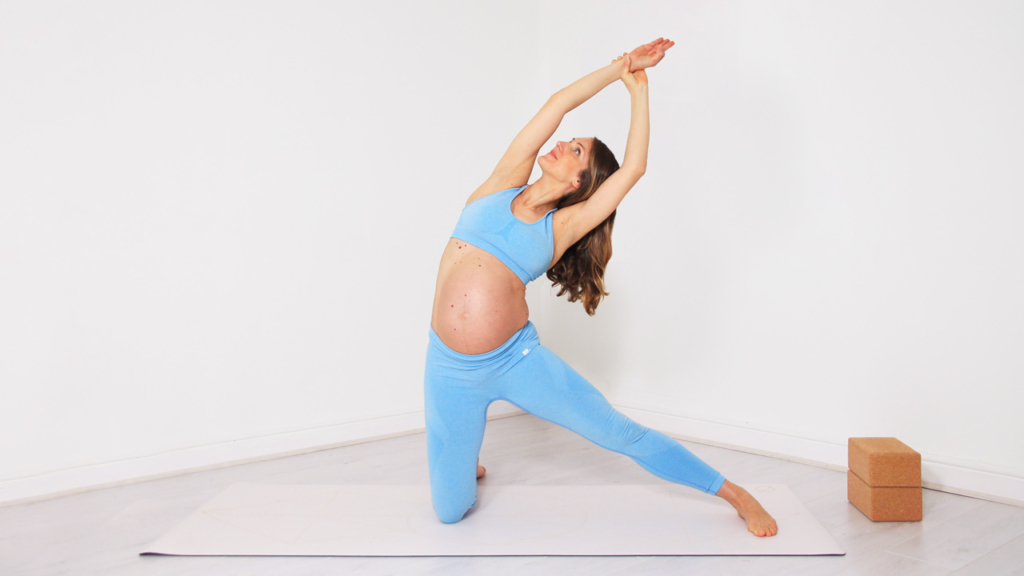
If you have a regular yoga practice, feel good in your body, have high energy levels and no particular discomfort, quitting your regular yoga routine and shifting entirely to prenatal-specific classes as soon as you get a positive pregnancy test result might not feel enticing or challenging enough to keep your endorphins high, and maintain the strength and stamina you have built up until now. You might therefore prefer to adjust your existent practice, while incorporating specific postures, breathing patterns and visualisations that are particularly important to prepare for labour.
However, with so much conflicting information you might wonder:
- How can I make sure what I am doing is appropriate for my changing body?
- Should I avoid any core work, twists or positions lying on my back when pregnant?
- Is it true that raising my heart rate is dangerous for my baby?
- Am I even allowed to join dynamic Vinyasa classes in my first trimester as some teachers say?
If you’re an experienced yoga practitioner and are looking for more information about how to adapt your practice during pregnancy, read Vanessa’s article, full of practical and evidence-based information to smoothly transform your practice till the last trimester.
4. Practice prenatal yoga with us!
- Pregnancy yoga classes for all trimesters, first, second and third trimesters
- A quick link to all our pregnancy yoga classes
- Prenatal Power! – a guided program for those with an established practice
- Postnatal yoga program – Build up your strength and regain your fitness after giving birth
- Ayurveda for Pregnancy – Self-care tools for before, during and after pregnancy
- Meditations for kids – Soothing audio meditations for children aged 3 and above
5. The best yoga poses for pregnancy
There are so many beneficial poses to practice throughout pregnancy, as many of them help relieve back pain, increase flexibility in the hips, and prepare the body for labour. When it comes to beneficial positions for pregnancy and encouraging baby to move into the optimal position for birth, think of positions and poses that help you achieve an ‘upright, forward and open’ (U-F-O) position. This could be anything from a supported Child’s Pose, a squat, or a modification of Downward Facing Dog with your hands at the wall. Especially if you have found out that your baby is in the breech position, poses that move you into the U-F-O position can be very helpful to encourage baby to turn head-down. Here are some of the best pregnancy yoga poses to practice:
Yogic squat
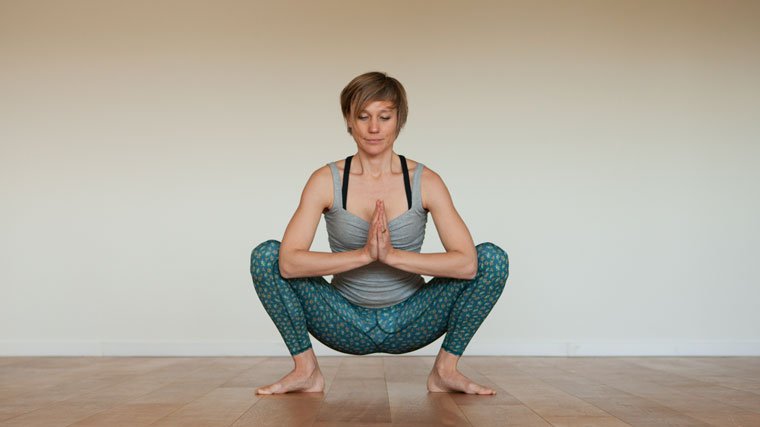
Perhaps the very best pregnancy yoga pose, the Yogi Squat can even be used as a birthing position itself. This posture helps increase mobility and flexibility in the hips and lower back, and can even help encourage baby to move into an optimal head-down position for birth.
Goddess Pose
Also known as ‘horse stance’, this posture helps strengthen the legs and hips, as well as creating space around the pelvis. You can practice this pose with feet slightly closer together if it helps you feel more comfortable, or wider apart if you want more of a challenge.
Modified Downward Facing Dog At The Wall
A wonderful pose to bring your body into a U-F-O position, this modification of Downward Facing Dog can help stretch out the spine and legs, as well as relieving back pain. This is also a position you may want to adopt throughout the first stage of labour, as it can provide a little restful relief.
Supported Child’s Pose
Using a bolster or cushion to support your growing bump, Child’s Pose is one of the best positions to give your body some much needed rest, and a gentle release for the lower back. throughout pregnancy, there may be days when all you want to do is rest and retreat, and Child’s Pose can help give you that sense of calm when it’s most needed.
Cat-Cow Pose
Another posture to encourage baby to turn head-down, cat-cow is also a great way to release tightness in the lower back, and maintain gentle core strength. Don’t focus too much on pushing into a deep back-bend, instead focus on moving slowly with your breath.
6. Yoga poses to avoid when pregnant
Yoga is a great way to care for your body and mind when pregnant, but there are still a few poses to avoid to keep you and baby safe. As always, listen to your body and stay away from anything that feels too uncomfortable for you, as well as these specific poses:
Postures that put pressure on your abdomen
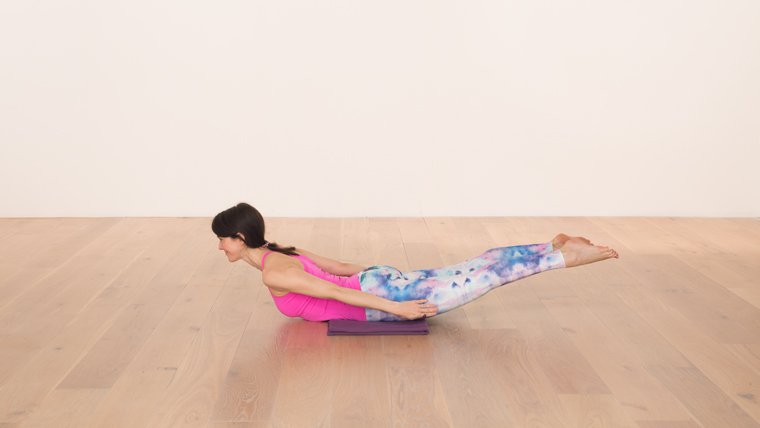
Salabhasana (locust pose) and any other posture that requires you to lie flat on your front should be avoided throughout pregnancy. Once your bump starts to grow, it will become pretty difficult to lie on your front anyway! Choose a hands-and-knees position instead, or take a few breaths in child’s pose if this pose is offered.
Navasana
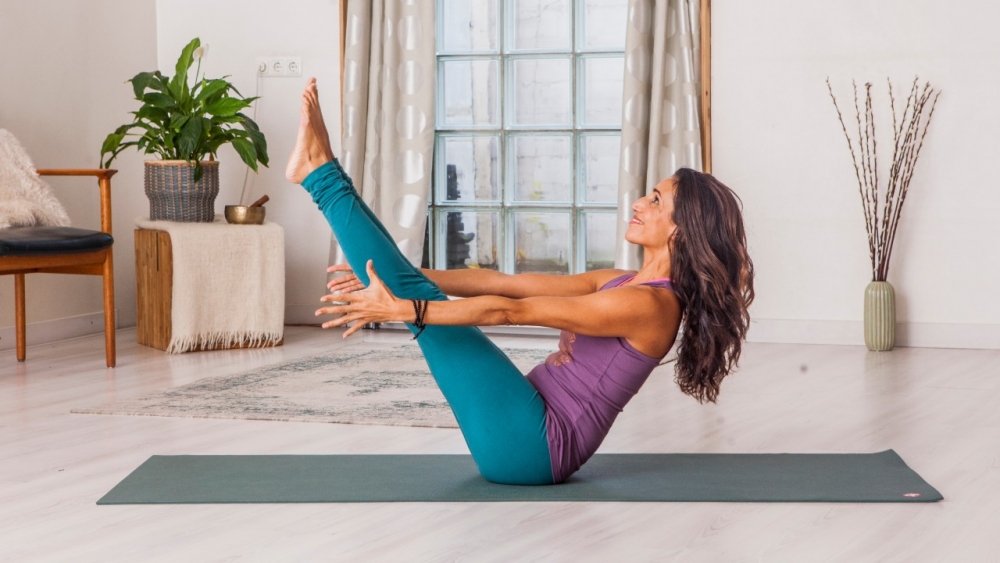
As we mentioned earlier, pregnancy is not the time to focus on targeted abdominal exercises. Too much emphasis on your abs can lead to separation of the abdominal muscles, so avoid poses like navasana (boat pose) for now. You can still maintain a strong core simply by engaging your pelvic floor whilst practicing pregnancy yoga, and practicing modified exercises from hands-and-knees.
Inversions
The main reason to avoid inversions in pregnancy is simply a matter of safety; we’re less in control of our movements when we’re upside-down, which could lead to injury. Inversions are also contraindicated if you have high blood pressure, which can become an issue later on in pregnancy.
Deep back-bends
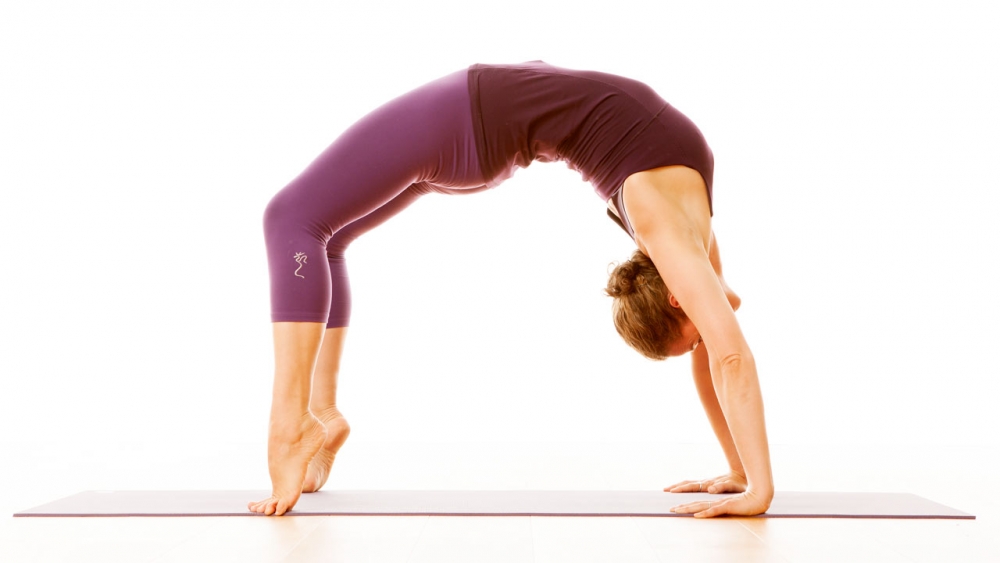
Whilst you may be able to practice back-bends in your first trimester, as your bump grows, this could become a lot more uncomfortable and potentially cause excessive back pain. During pregnancy, the hormone known as relaxin encourages muscles and ligaments to become much more flexible and lax, which means injuries can be more common. Instead of diving deep into Ustrasana (camel pose), choose gentle backbends and poses that help to stretch the chest and improve posture.
Poses that require you to lie flat on your back
As we mentioned above, lying flat on your back (especially as your baby grows bigger) can potentially press on the vena cava – a large vein that plays an important role in carrying blood and oxygen to your uterus and baby. Practice poses lying on your side instead, and lie on your left side with props for comfort during Savasana.
7. Breathing practices for pregnancy
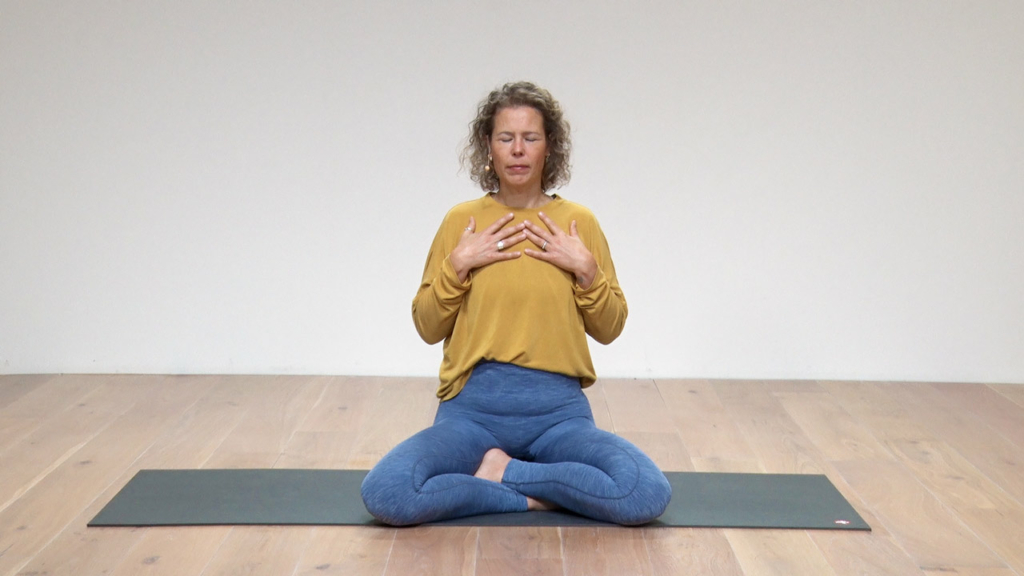
Whether you’re experiencing pregnancy-related anxiety, or approaching labour, caring for your mindset is key. Meditation and breathing practices have a direct impact on our emotions, and can be a huge help in reducing stress and anxiety throughout pregnancy and beyond. Meditation can take the form of visualisation, self-enquiry, a guided session, a simple relaxation or whatever works for you. The countless breathing practices to choose from (known as ‘pranayama’ in traditional yogic terms) can help with everything from boosting energy levels to calming the nervous system. Here are five meditation and breathing practices to try throughout pregnancy, postpartum and even labour, for a calmer, clearer mind:
4-6 Breath
You may come across this breathing technique if you try ‘hypnobirthing’ classes, as it’s a method thought to help reduce stress and soothe the intense feeling of contractions. Remember, the more relaxed you are, the less cortisol you’ll be producing, and – hopefully – the easier your birth will be. To practice; inhale through your nose for a count of 4, them exhale through your nose or mouth for a count of 6.
Golden Thread Breath
This method naturally encourages a slower, smoother, calmer exhale, which can help to shift us out of ‘fight or flight’ mode, and into a more relaxed state of being. To practice; inhale through your nose, then purse your lips and exhale slowly through your mouth, imagining a soft golden thread flowing from your lips.
Nadi Shodhana
A wonderful way to find calmness on those das when you may be feeling anxious about what the next chapter of your life will hold. Nadi Shodhana – also known as ‘alternate nostril breathing’, works to balance the active, fiery ‘sun’ energy within us, with our cool, calm ‘moon’ energy. To practice; using a finger or thumb of one hand, close off your right nostril, then inhale through your left. Then, open your right nostril and close the left, and exhale. Inhale through the right nostril, and repeat the cycle for a few minutes or as long as you are comfortable with.
- Try out Nadi Shodhana in this class with Esther Ekhart.
8. How to set up your prenatal yoga space
Unlike power yoga or Vinyasa flow, you may find yourself practicing more poses that encourage relaxation and restoration alongside strengthening poses and gentle movement in a pregnancy yoga class. Especially if you’re used to pushing yourself and choosing only the most challenging yoga classes, this can be a valuable lesson in slowing down and really listening to your body.
This is the time to invest in cushions, bolsters, blankets and blocks, so you can adapt your yoga practice as your body changes and your bump grows. Whilst some women may find they can continue to practice strong and flowing yoga classes throughout pregnancy, many women find they need a practice with slower movements and more stillness, due to feeling tired or nauseous. Always listen to your body and give it what it needs.
Create a calming atmosphere

Yoga isn’t just about your body – it’s very much about your mind too. Especially whilst pregnant, it is beneficial to bring about as much calmness and relaxation as possible, because the calmer you feel, the calmer your baby will feel in the womb. Think about what makes you feel relaxed; candles? Fairy lights? Warm colours? Specific images? Create a space that helps you unwind whilst you practice. You may also like to play relaxing music, because not only will this help you relax, but from around week 18 of pregnancy, babies will be able to detect sound too! Spritzing a little essential oil can also help encourage relaxation, however it’s important to research which essential oils are safe for you in pregnancy before using them.
Stock up on props
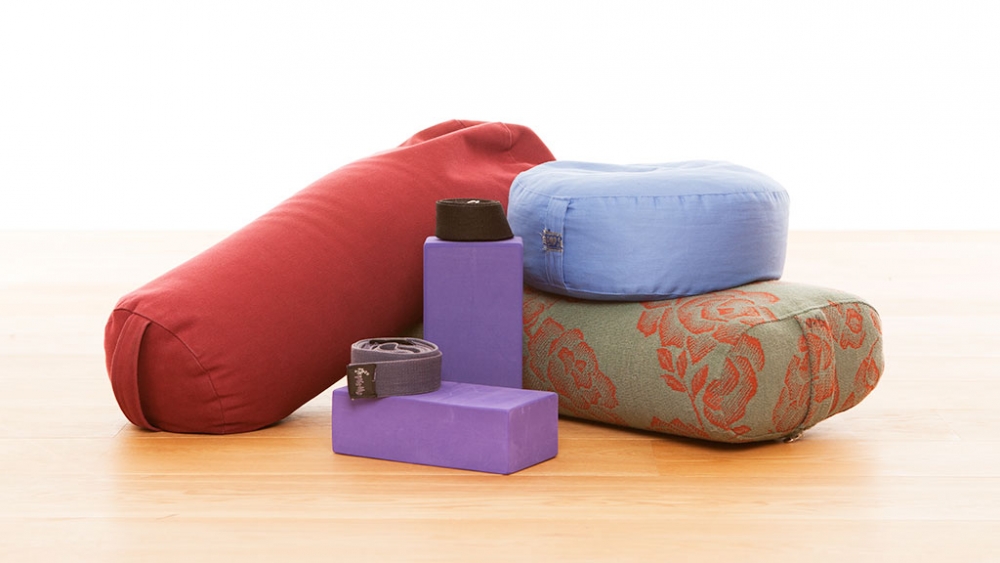
As we’ve said; your body is going to change a lot throughout pregnancy! Whilst you may feel physically pretty similar to your usual self throughout your first trimester, you’ll soon notice your baby bump becoming a central part of your practice, which can make it difficult to practice poses in the way you usually would. This is a great opportunity to learn how to adapt your practice to your needs, as well as practicing gratitude towards your body’s amazing abilities. Use blocks to support your hands if they don’t reach the floor any more, or to lift your hips in seated poses. A bolster is a brilliant way to support your body in restorative poses, whilst a belt or strap can help you gently stretch out tight hamstrings. To help enhance your relaxation, you can also use a blanket and eye pillow too.
Use affirmations
Pregnancy yoga classes often use affirmations or mantras, which you can also use in daily life and even during labour to promote a positive, relaxed state. By repeating affirmations, we can essentially ‘program’ the brain to fully embrace positivity and ease, even through challenging situations. Try affirmations such as ‘I am strong and capable of anything’; ‘My body knows exactly what to do’; ‘My baby and I are a team’; ‘My body and mind are relaxed’. Writing down your affirmations and placing them around the house can also serve as a useful reminder to repeat them on a daily basis.
Further reading:
- How to adapt your yoga practice during pregnancy
- Prenatal yoga – Tips for new and experienced yogis
- Baby salute – Pregnancy yoga Sun Salutation
- Surrender to change – a pregnant yoga teacher’s story

